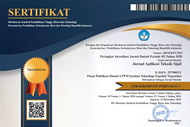Analisis Kerentanan Banjir Menggunakan Data Citra Satelit dan Machine Learning di Kota Surabaya
Abstract
Keywords
Full Text:
PDFReferences
Bronstert, A., & Bárdossy, A. (2003). Uncertainty of runoff modelling at the hillkelerengan scale due to temporal variations of rainfall intensity. Physics and Chemistry of the Earth, 28(6–7). https://doi.org/10.1016/S1474-7065(03)00039-1
Constantinescu, G., Garcia, M., & Hanes, D. (Ed.). (2016). River Flow 2016. CRC Press. https://doi.org/10.1201/9781315644479
Dang, A. T. N., & Kumar, L. (2017). Application of remote sensing and GIS-based hydrological modelling for flood risk analysis: a case study of District 8, Ho Chi Minh city, Vietnam. Geomatics, Natural Hazards and Risk, 8(2), 1792–1811. https://doi.org/10.1080/19475705.2017.1388853
Desalegn, H., & Mulu, A. (2021). Flood vulnerability assessment using GIS at Fetam watershed, upper Abbay basin, Ethiopia. Heliyon, 7(1), e05865. https://doi.org/10.1016/j.heliyon.2020.e05865
Ekeu-wei, I. T., & Blackburn, G. A. (2018). Applications of Open-Access Remotely Sensed Data for Flood Modelling and Mapping in Developing Regions. Hydrology, 5(3), 39. https://doi.org/10.3390/hydrology5030039
Jayakrishnan, R., Srinivasan, R., Santhi, C., & Arnold, J. G. (2005). Advances in the application of the SWAT model for water resources management. Hydrological Processes, 19(3), 749–762. https://doi.org/10.1002/hyp.5624
Kia, M. B., Pirasteh, S., Pradhan, B., Mahmud, A. R., Sulaiman, W. N. A., & Moradi, A. (2012). An artificial neural network model for flood simulation using GIS: Johor River Basin, Malaysia. Environmental Earth Sciences, 67(1), 251–264. https://doi.org/10.1007/s12665-011-1504-z
Kjeldsen, T. R. (2010). Modelling the impact of urbanization on flood frequency relationships in the UK. Hydrology Research, 41(5), 391–405. https://doi.org/10.2166/nh.2010.056
Lee, M.-J., Kang, J. E., & Jeon, S. (2012). Application of frequency ratio model and validation for predictive flooded area susceptibility mapping using GIS. 2012 IEEE International Geoscience and Remote Sensing Symposium, 895–898.
Liu, Y., & Smedt, F. (2004). WetSpa Extension, A GIS-based Hydrologic Model for Flood Prediction and Watershed Management.
Martinis, S., Kersten, J., & Twele, A. (2015). A fully automated TerraSAR-X based flood service. ISPRS Journal of Photogrammetry and Remote Sensing, 104, 203–212. https://doi.org/10.1016/j.isprsjprs.2014.07.014
Mojaddadi, H., Pradhan, B., Nampak, H., Ahmad, N., & Ghazali, A. H. bin. (2017). Ensemble machine-learning-based geospatial approach for flood risk assessment using multi-sensor remote-sensing data and GIS. Geomatics, Natural Hazards and Risk, 8(2), 1080–1102. https://doi.org/10.1080/19475705.2017.1294113
Ouma, Y. O., & Tateishi, R. (2014). Urban flood vulnerability and risk mapping using integrated multi-parametric AHP and GIS: Methodological overview and case study assessment. Water (Switzerland), 6(6), 1515–1545. https://doi.org/10.3390/w6061515
Pradhan, B., & Youssef, A. M. (2011). A 100-year maximum flood susceptibility mapping using integrated hydrological and hydrodynamic models: Kelantan River Corridor, Malaysia. Journal of Flood Risk Management, 4(3), 189–202. https://doi.org/10.1111/j.1753-318X.2011.01103.x
Shrestha, R. R., & Nestmann, F. (2009). Physically Based and Data-Driven Models and Propagation of Input Uncertainties in River Flood Prediction. Journal of Hydrologic Engineering, 14(12), 1309–1319. https://doi.org/10.1061/(ASCE)HE.1943-5584.0000123
Spachinger, K., Dorner, W., Metzka, R., Serrhini, K., & Fuchs, S. (2008). Flood Risk and Flood hazard maps – Visualisation of hydrological risks. IOP Conference Series: Earth and Environmental Science, 4, 012043. https://doi.org/10.1088/1755-1307/4/1/012043
Stefanidis, S., & Stathis, D. (2013). Assessment of flood hazard based on natural and anthropogenic factors using analytic hierarchy process (AHP). Natural Hazards, 68(2), 569–585. https://doi.org/10.1007/s11069-013-0639-5
Tehrany, M. S., Jones, S., & Shabani, F. (2019). Identifying the essential flood conditioning factors for flood prone area mapping using machine learning techniques. Catena, 175, 174–192. https://doi.org/10.1016/j.catena.2018.12.011
Tehrany, M. S., Lee, M.-J., Pradhan, B., Jebur, M. N., & Lee, S. (2014). Flood susceptibility mapping using integrated bivariate and multivariate statistical models. Environmental Earth Sciences, 72(10), 4001–4015. https://doi.org/10.1007/s12665-014-3289-3
DOI: http://dx.doi.org/10.12962%2Fj2579-891X.v21i3.15910
Refbacks

Jurnal Aplikasi Teknik Sipil by Pusat Publikasi Ilmiah LPPM Institut Teknologi Sepuluh Nopember is licensed under a Creative Commons Attribution-ShareAlike 4.0 International License
Based on work at https://iptek.its.ac.id/index.php/jats




